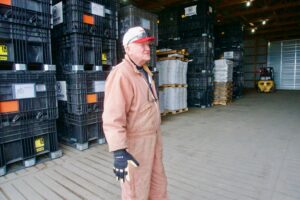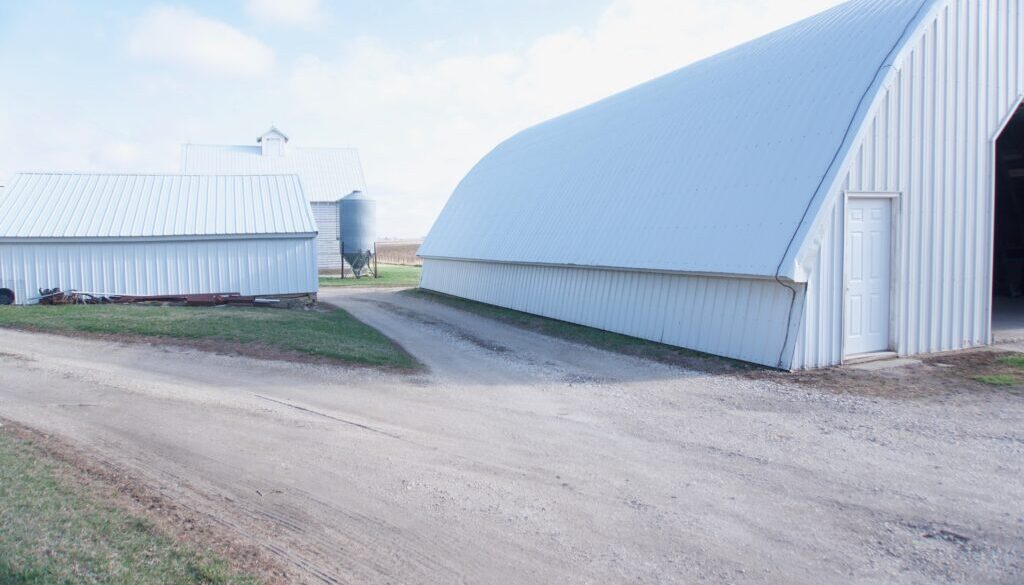An Iowa farm county seeks answers amid cancer rates 50% higher than national average
 EMMETSBURG, IOWA –Raised in rural Iowa, 71-year-old Maureen Reeves Horsley once considered her tiny hometown in the northwest part of the state to be a blessed space. She recalls a time when the streams here ran clean and the lake water was clear.
EMMETSBURG, IOWA –Raised in rural Iowa, 71-year-old Maureen Reeves Horsley once considered her tiny hometown in the northwest part of the state to be a blessed space. She recalls a time when the streams here ran clean and the lake water was clear.
The family farm where Horsley grew up was one of more than 1,200 farms in Palo Alto County in 1970. In her memory, the county’s 13,000 residents enjoyed a thriving agricultural-based economy and close-knit neighbors. Cows grazed in verdant pastures. And seemingly endless acres of corn marched to the horizon.
“We had good crops, corn and soybeans,” Horsley said of her family’s farm along the West Fork of the Des Moines River. “You could make it on a small amount of farmland. You felt safe. It was a good life.”
Two generations later Emmetsburg and Palo Alto County have been radically transformed into a place where many residents worry that the farms that have sustained their livelihoods are also the source of the health problems that have plagued so many families.
Horsley, a certified nurse practitioner who still lives in the county, is among many Iowa residents who ask whether the farms that make up the lifeblood of Iowa’s economy have become a source of disease and death due to the toxic chemicals and other pollutants indelibly linked to modern agricultural practices.
“We drank the water on our farm,” Horsley said in an interview. “My sister had breast cancer. She was only 27 when she died. She grew up here. My other sister had uterine cancer. As a nurse practitioner I’m aware of five people now with pancreatic cancer. I know 20 people who have other cancers or died of cancer here. Look at the obituaries in our newspaper. Everybody is aware this is going on.”
Cancer concerns mounting
Palo Alto’s 2022 tally of 842 farms generates nearly $800 million in annual market value. But nearly 400 small farms have been absorbed into bigger operations or otherwise stopped operating over recent decades, and Palo Alto’s population has dropped by 4,200 people since 1970.
Today’s Iowa farms are largely focused on raising hogs and growing corn, both of which are linked to numerous environmental problems. Farmers growing corn, for example, often rely heavily on applications of toxic pesticides and fertilizers, while livestock operations generate millions of tons of manure annually. The chemicals and manure pollute food and water consumed by people even far from farm fields.
When nitrogen from fertilizer and manure combine with oxygen they create nitrates, which routinely drain from farm fields into groundwater, streams, and rivers, contaminating water sources. Babies can suffer severe health problems when consuming nitrates in drinking water, and a growing body of literature indicates potential associations that include an increased risk of cancer. Exposure to elevated levels of nitrates in drinking water has been linked by researchers to cancers of the blood, brain, breast, bladder and ovaries.

As well, there are years of research showing that many herbicides and other pesticides applied to farm fields are linked to cancers and other diseases. The National Cancer Institute and the National Institute of Environmental Health Sciences have been funding research to investigate the links between disease and farming for more than 30 years, focusing their work on people in Iowa and North Carolina. Among the findings are links between pesticides and malignant brain tumors, multiple myeloma, pancreatic cancer and certain breast cancers.
Concerns about connections between the farm pollutants and cancer have been mounting, particularly in Palo Alto County, which had the highest incidence of cancer of any county in the state and the second-highest incidence of cancer among all US counties, with 83 new cases of cancer on average each year, in a population of 8,996, according to a 2023 report by US News.
The five-year incidence rate for cancer in Palo Alto County is 658.1, far higher than the national five-year average of 442 new cancer cases reported for every 100,000 people, according to the National Cancer Institute.
The concerns are not limited to Palo Alto County: Iowa has the second-highest and fastest-rising cancer incidence among all US states, according to a 2024 report issued by the Iowa Cancer Registry. Cancer incidence in Iowa stayed mostly steady from 2001 to 2010, then dropped briefly before starting an upward climb after 2013, according to federal data.
Medical experts and state health authorities say it is difficult to pinpoint exactly what may be causing the prevalence of cancer in Palo Alto and Iowa overall. But many residents believe there is little doubt that the answers lie in the tide of farm pollutants pervading the environment.
“We are so heavily into agriculture in Iowa,” said Horsley said. “Big chemical use. Big nutrient applications. What effect is that having on people? There needs to be more research on that.”
“So much pain”
David Dunn and his wife, Sharon Kendall-Dunn, reside in the city of Davenport, Iowa, some 300 miles south and east of Palo Alto County. Still, they wrestle with their own concerns about the impacts farming and farm-related pollution may have on their health. Ten years ago the couple learned that a mass in David’s abdomen was non-Hodgkin lymphoma (NHL), a cancer common in farm country nationally.
Though the couple did not work or live on a farm, their doctor indicated the environment could be to blame. Sharon remembers that when she asked the doctor how her husband could have gotten the disease, he told the couple simply – “You live in Iowa.”
Two years ago Sharon was also diagnosed with cancer, a type called chronic myeloid leukemia, which begins in the bone marrow. So far, treatment has helped keep her disease under control.
“I was in so much pain,” she said. “It’s better now.”
David’s cancer is also undergoing treatment. But the impact on his life and his future has been dramatic.
“This is some kind of crazy,” said David. “I stopped dreaming. I stopped dreaming about retirement. I stopped dreaming about the kids graduating from college. I didn’t think I’d see them get married. I didn’t think I was going to hold a grandkid.”
Both Sharon and David grew up in Iowa. Other friends and family members have also been diagnosed with cancers, and some have died.
In the tiny farming town of Long Grove, Iowa, Chris Green mourns the 2019 death of her husband, who was stricken by the deadly brain cancer known as glioblastoma. With aggressive treatment, Jim Green lived nearly two years following his diagnosis but ultimately succumbed.
“He said to me, ‘You know, I can’t do this anymore.’” Chris recalled. “So we had hospice come in. Jim passed in the living room… surrounded by family.”
Before he died at age 65, Jim worked nearly 39 years on the maintenance staff of an aluminum plate rolling mill in Davenport. His exposures to various industrial chemicals there could have been a factor in his disease, but some studies also link pesticides, such as those used commonly on farms, to glioblastoma.
Chris said she knows of at least nine other people in her community who have died from glioblastoma in the last several years.
“What you’re seeing in Iowa is a problem,” said Molly Jacobs, an epidemiologist at the University of Massachusetts. “You can see it from the experience on the ground. The message from me is to put energy into reducing exposure to the known harms.”
“We need to find out what’s going on”
The pesticides used on Iowa farmland are seen as a likely culprit for at least some of the cases, experts said.
“We have a very high percentage of our land that is growing crops,” said Dr. Richard Deming, an oncologist in the state’s capital city of Des Moines. “The current way of growing crops is to use a lot of ag chemicals, which have improved the yield of crops. Is there, potentially, a downside? That’s where we really need to do more research. There is certainly circumstantial evidence that we’re probably exposed to more ag chemicals just because of the nature of Iowa, and the number of acres of Iowa that are under agricultural production.”

Living in a place with cancer rates nearly 50% higher than the national average prompted Linus Solberg, a farmer and Palo Alto County supervisor, to ask area health authorities for assistance in understanding the sources for disease and reducing risks. He said he knows state universities have studied the problem, but sees little being done to address the risks.
Solberg’s father developed prostate cancer, and his mother died at age 69 of ovarian cancer, while his wife and three neighbors on his road also died of cancer.
“So that’s six right there on two miles along this road,” he said. “I don’t know if its pesticide, or electrical. We have all these windmills. I don’t know if it’s in the water. I have no idea.”
The county’s health authorities say they are expanding screening programs for breast, lung, prostate, and colon cancer, counseling residents on smoking and diet, and testing homes for radon, a naturally occurring radioactive gas and a proven carcinogen.
“Organizationally, we’ve concentrated on early detection, and health and wellness,” said Jonathan Moe, chief executive officer of the Palo Alto County Health System.
The county also tests residential drinking water wells for contaminants under a state-funded program.
Ben Huntley, the environmental health specialist who manages the program, sampled 121 homes over the past 24 months. According to his records, three samples were above the 10 parts per million federal drinking water limits for nitrates.
The much larger hazards were E.coli bacteria – 30 samples above safety limits – and arsenic, a naturally occurring mineral and a carcinogen linked to lung, bladder, and kidney cancer – that exceeded the safety standard in 45 wells.
Settled by Irish immigrants in the mid-19th century, Palo Alto County has endured bad crop years, the deep drought of the early 20th century, and the 1980s farm crisis. Now cancer is laying claim as an Iowa calamity.
“In the old days, the farmers lived longer lives if they didn’t die from an accident on the farm,” Horsley said. “Now everybody is getting checkups and finding out they have prostate cancer, or they’ve got glioblastoma, or they’ve got cancer in the lymph nodes. We need to find out what’s going on.”
(Keith Schneider, a former New York Times national correspondent, is senior editor for Circle of Blue. He has reported on the contest for energy, food, and water in the era of climate change from six continents. )
(Featured photo of the Solberg farm in Iowa, by Keith Schneider.)





May 14, 2024 @ 4:17 pm
It’s lucky some guy at your water company has a job sitting in an office in Davenport counting the amount of fluoride everyone ingests, breathes, or otherwise absorbs, to work out how fluoridated their water should be that day. As long as you stay away from phosphate fertiliser, smelters, steelworks, brickworks and ceramics works, photovoltaic manufacturing, IC chip manufacturing, coal burning, biomass burning, motor exhaust, welders, waterproofed items, tea, fish, chicken skin, mechanically recovered meat products, the 20% of pharmaceuticals that are fluorinated such as antidepressants and antibiotics, air dusters, lithium battery fires, fire suppressants, refrigerants, 50% of agrochemicals, and steer clear of nerve gases and anchovies, you’ll be supporting biome fluoridation and saving a lot of worry.
Otherwise, check out the cancer section at the Fluoride Index http://www.nfl.si/fi.
May 10, 2024 @ 3:15 am
Robert F. Kennedy Jr. Spent over 40 years defending average citizens from these powerful corporations known to be responsible for atrocities like these. I sincerely hope everyone reading this can find it in themselves to refrain from being pulled into the tempting Red vs Blue charade that is pushed onto us every four years; a self-fulfilling prophecy resembling a WWE storyline. Please abandon the devicive, corporate backed political parties and instead vote for RFK JR; the only man talking about these issues. The only man who can help our fellow Iowans fight against these heartless, rich, powerful companies with a strangle hold on our political system.
May 9, 2024 @ 12:37 pm
I grew up in Palo Alto County on a farm just 14 miles from Emmertsburg. My grandfather had been diagnosed with bowel cancer, his son, my father, died of squamous cell of the lung at age 59, his brother had prostate CA, his sister died of bladder cancer, and I was diagnosed with invasive ductile cell CA of the breast. My aunts 2 son’s had CA , one was death from brain tumor and the other had rectal Ca(still alive)
My oncologist tested me for familial traits that were negative, and she said “environmental”. there were others in our “section ” that died of cancer before my father in 1982. I left home in 1971 for nursing. Your article is so interesting and amazing frightening. I remember pumping water from outside for all purposes, esp drinking.
May 10, 2024 @ 1:30 am
Rae, thank you for adding your history. Indeed- we need more studies n recommendations 👍
May 9, 2024 @ 11:35 am
The US government allows various pesticides and herbicides that are banned in other countries. Kim Reynolds has signed legislation that makes illegal to sue these chemical companies for damages. The pollution from these chemicals is the problem. There does not need to be more reasearch done, we know what is causing cancer, it is these chemical companies lobbying extraordinary amounts of money to be able to poison Iowa and other farm states.
May 9, 2024 @ 6:02 am
Lives in iowa for thirty six years. As an avid fisherman in the state I can tell you firsthand there is not a single river in the state that does not reek of Round-up herbicide. Especially in the spring or after a rain. You dont realize rivers arent supposed to smell this way because you associate the smell with a river. It’s not until you move away and spend time next to other bodies of water do you realize what you were smelling was actually pesticide. Agriculture has actively destroyed anything natural in the state of iowa. Agriculture and everything associated with it so pervasive in that state.
My first wife died of colon cancer at the age of 33 in 2019. Shed li ed in iowa her whole life. I often wonder if all the pesticide and herbicide in the water had contributed to it any way.
May 8, 2024 @ 4:39 pm
Vote Kennedy to help clean up our polluted ground and water.
May 9, 2024 @ 11:40 pm
Agreed! He is prepared to take on and dismantle the regulatory agencies like EPA and NIH that are currently bought and paid for by food, pharma, and big ag ( chemical) industry. He has done it his whole career. This article is sad and we CAN be a people of action.
May 8, 2024 @ 3:29 pm
Northern Iowa to Des Moines, Iowa is in the Des Moines Lobe which is an area underground that has toxic trace minerals seeping into the ground water. All dumped here by the glaciers. Add some herbicide and pesticides to the ground now we got really potent toxic water. The cancer outbreak has been going on for over 50 + years especially in the western part of Iowa. Radon is found in almost all basements in Iowa. It was here before we were here farming. Heck in Montana and North Dakota babies of settlers were born blue because of the toxic ground water. When the government figured it out they then forced the Native Tribes to relocate on reservations in that same area knowing the water was toxic.
So if the soil and water are toxic , don’t you think that any thing grown or growing with the water and in the soil would be showing signs of toxicity? Answer to the billions of dollars question is YES.
May 8, 2024 @ 1:54 pm
My wife just went home and I have come to the conclusion the CANCER industry doesn’t want to cure you.
My friend Dave Olson 952 237 0869 had 17 doctors tell him on September 06 go home your not going to see 07.
Go to Hoxsey Bio Medical Center 619 407 7858 and success stories
He had volleyball size tumor and his entire body was full of tumors.
By March of 07 he w a s and is cancer free
May 8, 2024 @ 4:57 pm
They do not big pharma rule and make more money from CURING u,, with more poisons. We got chemtrails, we got Bayer asking for round up to b b blessed again by those who should say no, since it’s known to cause cancer, and of course they’ll say yep sure. Gov has actually experimented on citizens for years they were ordered to stop but we all know how well and often they do the right thing , it’s like states BANNING chemtrails,, if they did this why would they have done it in the first place? Appease, Act like peoples lives r important, tell them a story and continue.. so sad for all affected
May 8, 2024 @ 1:24 pm
Shouldn’t be hard to figure out…just hard to prove.
We’re doing it to ourselves with Help from the corporate world.
May 8, 2024 @ 12:24 pm
Thanks for this information. As a former ’70’s Iowa farm girl from Grundy county, I have seen the drastic transformation of where i grew up. How has the tiling of farmland affected pollution? Lots more tiling and clearing of timbers has been done in the last 10 years of our farms. When on a trip back home i went swimming at the local town pool which had corn fields right up to the parking lot. While back floating in the pool, a spray plane made several passes over the pool filled with many children and let out a smelly mist of something without warning as it started across the edge of the field. I asked the lifeguards what the deal was and the said they do that all the time.
May 8, 2024 @ 11:59 am
Yes you can be it’s all the chemicals used for farming killing weeds and all the stuff added to food such as growth hormones for animals. It all affects humans. Best advice go vegan or organic do not buy or drink dairy or any meat products. We used to farm and I’ve changed and my family’s changed how we eat.
May 8, 2024 @ 11:58 am
I’m a farmer in Northern Iowa. The hog manure you cite as a problem actually works symbiotically to DECREASE the amount of pesticides and herbicides that corn farmers use. Pig manure is the greatest asset corn farmers have available. ALL hog confinements are required by law to have a manure management plan on file with the USDA and know what crop grounds will receive this organic “goodie” in place of chemicals. Your info is flawed and one sided, you decided farmers were to blame for cancer already, then wrote your article. Do your research before you turn more Iowans against farmer and more small family farms get run out of business. Articles like this do exactly that. Meanwhile family farms like ours are working diligently to stay afloat and do right by our land and the humans who dwell upon it. We are ALWAYS thinking of ways to protect the people and the land which we steward.
May 8, 2024 @ 1:41 pm
Farmers aren’t to blame, at least certainly not all of them. Many of the greater societal systems that surround and drive farming are. While this article struck a nerve for you, contemporary farming cannot be overlooked as a potential source of reasons for high cancer rates in Iowa. The article also mentioned heavy metals and radon. I know of many farmers that are choosing less toxic methods of farming and getting “the man” out of the picture by direct selling to their community. Together we can be creative and successful in meeting needs in a healthier way.
May 8, 2024 @ 3:24 pm
Why do you people deny science? It gives Iowans a bad reputation.
May 8, 2024 @ 3:31 pm
While driving round-trip from southern Michigan to the Springfield, Illinois area a few weeks ago, I was incredibly disappointed to see almost no cover crops and very little evidence of no-till practices in both Illinois and Indiana corn/bean growing areas. This, in spite of overwhelming evidence that such practices improve soil health and reduce runoff from farm fields. It seems pretty obvious to me that those farmers don’t care much about people and their own soil. The last I knew, confinement hogs were given an assortment of chemicals in their feed, some of which comes out the other end along with e-coli and other potentially harmful bacteria. We have had over two inches of rain in the past week and our rivers this morning are brown with soil and whatever pre-emergence chemicals and animal waste were applied to recently tilled, nearby fields. (I am close to dairy, hog, and chicken confinement operations.) I am not opposed to using animal waste as fertilizer when it lands on pasture or prairie grass, etc. where there are living roots and an abundance of microbes to convert the nutrients into compounds that plants can use. Maybe Iowa has changed? But the last I knew it was pretty much like Illinois and Indiana, and indeed my own county in Michigan, where too many nutrients and too many pesticides are applied or knifed in to bare ground or coating the seeds being planted. It washes away far too easily.
As the article clearly states, much more research needs to be done-but the correlation is pretty obvious. In the meantime, I applaud farmers who are taking advantage of farm programs that help them hold their soil, hold those nutrients in place so plant roots can absorb them, increase biodiversity on their lands, and work with environmentalists and the medical professionals who are trying to address climate and health concerns.
May 9, 2024 @ 6:08 am
Yeah but I’m guessing you still dump thousands of gallons of round up on your fields every year. I’m betting your rivers and streams nearby all stink of round up. Ita not supposed to smell that way. Pretty sure ita in all the ground water. Farming practices are to blame for high cancer rates in iowa. And since farmers see it as threat to business as usual we’ll just ignore anything that points toward grow crops as a culprit for shitting on the environment. All the the farmers I know biry their heads in the sand on this issue.
May 9, 2024 @ 9:22 am
Do you think people don’t follow the plans? Is that really the problem instead of the actual waste?
May 9, 2024 @ 11:13 am
Bless you. Articles like this raise multiple red flags. There are so many who will out and out lie to fear & hate monger since there’s profit in it. They target an element I saw recently referred to as “food concerned”. A euphemism for what seems to range from excessive anxiety to fanaticism. Some just like to use farmers, seed companies & scientists as punching bags. But they are the experts to seek about these claims, all, btw, expressed w/words such as may.. might.. could. And, the sources they cite all seem to conclude their “studies” with “no causation was found”, “more research is needed”. With all the accusations, the USA ranks #1 in the world in Food Safety, Protein Quality & Nutritional Standards; Global Food Security Index 2022 – 113 countries.
May 8, 2024 @ 8:36 am
I farmed. I am 70 wìth.lots of health problems
May 8, 2024 @ 10:47 am
We are so sorry to hear about your health problems. Sadly, so many farmers also suffer health issues.